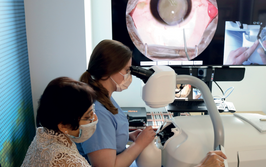Lasers or Lenses?
Deciding between laser vision correction and intraocular lens implantation is a question of technological advances, surgeons’ preferences and patient education
The goal of refractive surgery for myopia is to safely and stably achieve a patient’s desired refractive state. There’s more than one way to accomplish this, though – either by laser refractive surgery or by implantation of a phakic intraocular lens (pIOL). Sometimes, the options are clear.
Though there are some instances where ophthalmologists show clear preferences – such as laser surgery for patients with low myopia, or pIOLs for people with high myopia or who are otherwise ineligible for laser surgery – in many cases, patients occupy a grey area in which either procedure could be appropriate. How, then, do ophthalmologists decide which type of refractive surgery to recommend? At what degree of myopia is a phakic lens preferable to laser ablation? Official guidance as to which option is the most appropriate varies across European countries but in general, where there’s no clear option, there’s no clear guidance – the final decision comes down to the ophthalmologist’s advice, and the patient’s preference.

Figure 1. Visian ICL lens implant, in position behind the iris and in front of the natural lens.
A Cochrane review has recently been published that compared laser refractive surgery to pIOL implantation for the correction of moderate-to-high myopia (1). The review included three clinical trials that involved a total of 228 eyes, and found that following:
- There was no significant difference between either group in the chance of patients having 20/20 (or better) uncorrected visual acuity
- pIOL surgery was considered safer to excimer laser surgical correction as it resulted in significantly less loss of best spectacle corrected visual acuity (BSCVA) at 12 months postoperatively
- Phakic IOL surgery appears to result in better contrast sensitivity than excimer laser correction
- Phakic IOL surgery also scored more highly on patient satisfaction/ preference questionnaires.
- Neither technique resulted in any complication that caused a loss of final BSCVA
So is the matter settled then? The Cochrane Review’s authors, Allon Barsam and Bruce Allan stated that these data should be examined with caution: the available evidence is of relatively poor quality, and called for more randomized, controlled trials that are adequately powered for subgroup analyses and have longer follow-up times are necessary to reach definite conclusions. We spoke to two eminent ophthalmologists to canvass their views on the matter: Bruce Allan, and Erik Mertens.
Bruce Allan

Bruce Allan
Your Cochrane review has been updated – but no additional trial data has been added over the last version. What’s changed in terms of its recommendations?
Very little. Very few randomized trials of phakic implants versus laser correction in refractive surgery have been performed, and of those that have, a lot of them are quite old. It’s old data, and that’s one of the problems of the review. But the other big problem with the review is that you’re comparing apples with pears, in a way. The patients see this straight away. You’re comparing an intervention, laser, where all of the complications and the risk are front-loaded in the early post-operative period, versus an intraocular technique that leaves an implant in the eye, for which there are question marks over long-term safety. So although we did definitely demonstrate advantages for vision for pIOL recipients from the comparison with the trial data that does exist, you’ve got to bear in mind that these trials only looked at short-term outcomes, and so the question for the patient is bigger than that. What is the best option for the long term? That question, you can’t answer from randomized trials for obvious reasons. You can’t do trials with a 50-year follow-up!
Having said this, some pIOLs have greater long-term risks than others. The ICL, which is now the most widely implanted pIOL, has an excellent safety record stretching back to 1992. The only real concern for ICL recipients, and this is theoretical, is that patients may develop a cataract earlier than they would have done otherwise. Less than 1 in 20 patients will develop a cataract within 5 years of ICL implantation. Cataract surgery is technically straightforward after ICL implantation, and still leaves patients with their myopia corrected. So, in reality, any long-term risk associated with ICL implantation is very well contained. Wearing contact lenses is often difficult for patients with higher prescriptions, and has its own risks. Informed patients understand these arguments well, and, interestingly, ICL recipients scored lower than contact lens wearers with the same level of myopia for ongoing concern over eye health in a recent questionnaire study.
A patient walks into your clinic. When is a pIOL the better option for them?
It’s a better option outside the range for LASIK. In our practice, we use the SCHWIND Amaris laser, which is very accurate and produces very nice results, and we treat up to 10 D of myopia with that, and up to 4 D of hyperopia (depending on corneal steepness). Outside that range, you’re looking at a lens.
The other big group of patients in whom you prefer a pIOL are those ineligible for LASIK because of ocular surface problems, or keratoconus. Those are the main decision-guiding factors in my head.
Low-power pIOLs are extremely useful in patients that have reached the limits of refractive surgery, either in ablation depth or other reasons that you wouldn’t want to laser a second time, and they can be useful for eliminating residual refractive error in those patients.
Is the fact that you can take the pIOLs out valuable?
It’s a valuable thing to have. It’s a good answer to patients that start out with the perception that LASIK for patients with 10 Diopters of myopia is a non-aggressive procedure! It works well, but if you start out with a preconception that an implant is more invasive than LASIK, you need to factor in the pathway back out of it. The fact is that you rarely need to back out of these procedures. Why would you? I can’t think of a single time where I’ve had to take an ICL out for dysphotopsia symptoms, and I’ve been implanting them for over ten years. It’s a theoretical benefit, yes, but it’s no more than that.
Do you see many – any – cases where you’ve needed to remove a pIOL?
I currently implant STAAR Visian ICLs, and the good thing about this ICL versus other phakic implants is safety. Endothelial attrition has been a problem with pIOLs in the past, but it’s not a big problem for the long-term in most patients using this ICL. However, there’s still a question mark over cataracts in ICL-receiving patients, who need to know that they might develop a cataract earlier in life than they otherwise would have if they’ve had an ICL implanted. That’s not true for laser refractive surgery.
Are there any other cases where you might use a pIOL/ICL?
There’s definitely a crossover between ICL implantation and refractive lens exchange. The one thing that’s shifted in my own practice – and this may well be a general trend – is that I’m much more keen to use ICLs in patients in the 45 to 55 year age-group now, than previously. I think these patients still have useful accommodation, whereas in the FDA study (1), I believe that the cut-off was 45 years, and ICLs weren’t implanted in presbyopic patients at all. I’ve had good results in implanting people in that age-range recently – and I think there’s much more of a shift towards that, and away from refractive lens exchange, particularly in the high myopes in that age-group. Part of that move has been informed by the risk of retinal detachment – it’s not increased in ICL recipients, whereas there is this big debate at the moment about the risk of retinal detachment after refractive lens exchanges.
Bruce Allan is a Consultant Ophthalmic Surgeon at Moorfields Eye Hospital and is the Service Director of the Refractive Surgery Service at Moorfields. Allan has performed laser refractive surgery since the early 1990s and has implanted pIOLs since 2003.
Erik Mertens

Erik Mertens
How long have you been implanting pIOLs?
Since 2002 – I’ve implanted more than 3,000 since then.
What’s your patient selection protocol? Who are the candidates for pIOLs implantation?
Every patient is a candidate for a phakic lens – all diopters of myopia, from -1 to -20 – unless there is a contraindication. But of course, even laser refractive surgery has contraindications. My problem with laser refractive surgery is that it can, in many cases, induce dry eye symptoms. Also, we see that – compared with corneal laser surgery – the refractive stability over time is better with phakic lenses.
What has been your experience with the Visian ICL implant?
Consistently good results. Before the Visian ICL CentraFLOW (V4c) model came out, we had to make an iridotomy or a surgical iridectomy. The iridotomy could be bothersome for the patient; it could be uncomfortable, and light entering through the iridotomy could sometimes cause visual symptoms. We’ve been working with the V4c for the last 3 years now, and we’ve never seen that problem since we switched.
The number of ICLs we’ve implanted has grown exponentially; to begin with, my practice had 6 percent of patients receiving pIOLs and 94 percent receiving laser vision correction (LVC) surgeries. Now it’s 92 percent ICL and 8 percent LVC. It has completely flipped from 12 years ago.
One of the concerns raised about pIOLs is the paucity of long-term safety data from clinical trials. You have implanted more ICLs than most. What has been your experience in that regard?
The first phakic IOL that I implanted was in 1992, so I’ve been implanting them for well over 20 years. There used to be problems with endothelial cell attrition with posterior chamber phakic lenses, but (unlike today’s anterior chamber IOLs) that’s no longer a problem with the current Visian ICLs. We’ve had over 3 years’ experience with the V4c, and we have not had a single case of an eye losing a line or more – all were either the same or gained a line.
And cataract?
I haven’t seen a single case of cataract yet with the V4c either. The risk factors for cataract development in these cases are low vaulting, myopia over 12 D and being over the age of 40 years. I have cases in all of those three categories, and yet I’ve seen no problems so far with the V4c – zero cataracts. The development of the hole in the center of the ICL’s optic – KS-AquaPORT – which encourages normal aqueous circulation in the V4c, is probably why we haven’t.
Some patients perceive “laser is better”, and view ICL implantation as “more invasive”. How do you inform patients of the options?
When a patient calls our clinic wanting refractive surgery, we send them a brochure that mentions the possibility of phakic lenses, and we position the phakic lens in the same section as laser surgery. Also, the more phakic implants we do, the more our staff see the benefits over laser vision correction. So when the patient is going through their pre-operative examination, they talk with the staff, and speaking from their own experience, they can tell the patient that phakic lenses give a better quality of vision than laser vision correction, with fewer side effects.
What drove you to start implanting ever-greater proportions of ICLs relative to laser vision correction?
Dry eye is almost always present with LASIK. When I see a patient one month after LASIK surgery, they say “I’m happy, but…”. There’s always a “but”. You don’t always see that with an ICL. Actually, one of my optometrists told me that when you do ICL surgery, one day post-operatively, patients don’t complain, but one day after laser surgery, patients have many questions. They may see 20/20, but they’re still squinting their eyes. It’s not about seeing 20/20, there’s also the comfort and ease in achieving that result… it’s very important.
Some ophthalmologists perceive that pIOL implantation has a lower profit margin than laser vision correction surgery. Is that your experience?
Well, I do not agree. When you use the femtosecond laser, you have the patient interface, you have yearly cost for the laser – for the excimer and the femtosecond laser – and these costs add up. I don’t think that it’s more profitable to do laser surgery.
Where do you see refractive surgery going in the future?
I think you need to preserve the cornea. It’s a difficult part of the eye, it’s elastic, and more and more patients are complaining about dry eye without having corneal surgery done, so touching the cornea is not the best option. I think in the future, the best option will be intraocular surgery in all cases.
Erik Mertens is Medical Director of the Medipolis Eye Center in Antwerp, Belgium. A hugely experienced ophthalmic surgeon, Mertens has been implanting pIOLs since 2002.
- ICL in Treatment of Myopia (ITM) Study Group, “United States Food and Drug Administration clinical trial of the implantable collamer lens (ICL) for moderate to high myopia: three-year follow-up”, Ophthalmology, 111, 1683–1692 (2004).

Bruce Allan’s principal research interests are enhancing treatment accuracy in laser refractive surgery, new techniques in corneal endothelial transplantation, and early intervention and visual rehabilitation in keratoconus. An extremely prominent corneal surgeon, Allan has been a consultant ophthalmic surgeon at Moorfields in London since 1998. Outside of work, he’s both a keen sailor and an ardent football fan.













